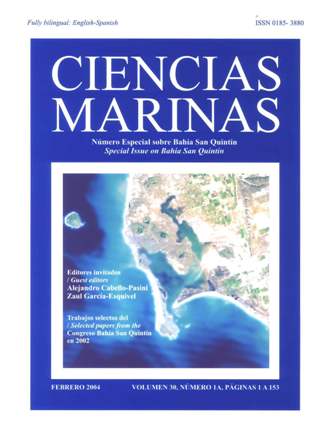Composition, importance and movement of fishes from San Quintín Bay, Baja California, Mexico
Main Article Content
Abstract
Monthly samplings were conducted at San Quintín Bay (Baja California, Mexico) in 1994 to determine the fish species assemblage, their abundance, frequency of occurrence, and movement. The sampling gear used included the otter trawl and beam trawl (5 and 10 m depth), beach seine net (<3 m depth), gillnet, and hook and line. The 5 and 3 m depths were characterized by seagrasses. A total of 64 fish species were identified. The most important species according to the index of community importance (abundance and occurrence) were the bay pipefish (Syngnathus leptorhynchus), the California halibut (Paralichthys californicus), the shiner surfperch (Cymatogaster aggregata), the diamond turbot (Hypsopsetta guttulata), and the black surfperch (Embiotoca jacksoni). Other abundant species were the topsmelt (Atherinops affinis), which inhabits the zone close to the beach, and the slough anchovy (Anchoa delicatissima), a temporal visitor to the lagoon. Low temperatures were recorded during April and May, coinciding with a movement of fishes towards the inner part of the bay.
Downloads
Article Details
This is an open access article distributed under a Creative Commons Attribution 4.0 License, which allows you to share and adapt the work, as long as you give appropriate credit to the original author(s) and the source, provide a link to the Creative Commons license, and indicate if changes were made. Figures, tables and other elements in the article are included in the article’s CC BY 4.0 license, unless otherwise indicated. The journal title is protected by copyrights and not subject to this license. Full license deed can be viewed here.

